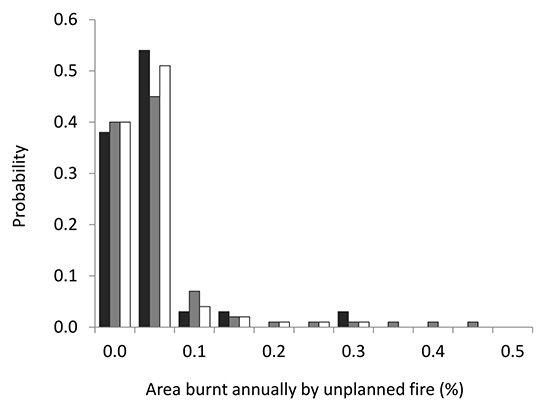
Ecological Archives A025-017-A2
K. M. Giljohann, M. A. McCarthy, L. T. Kelly, and T. J. Regan. 2015. Choice of biodiversity index drives optimal fire management decisions. Ecological Applications 25:264–277. http://dx.doi.org/10.1890/14-0257.1
Appendix B. Annual probability of wildfire in Triodia scariosa mallee vegetation, within the Murray Sunset National Park.
A frequency distribution of the annual wildfire history in T. scariosa mallee vegetation from 1972–2011 within the MSNP was created from the digital mapping of high quality satellite images of fire scars (Avitabile et al. 2013). Fire scars of known prescribed burns were not included (except one which escaped containment). The size-frequency data, with annual area of wildfire pooled to the nearest 5% of the total area, was fitted to a log normal distribution. These data do not represent the natural disturbance regime due to government policy requiring all unplanned wildfires to be fought (Hargreaves 2007) and the assumption that firefighting efficiency has increased since the 1970s. Due to uncertainty in the efficacy of different management strategies to alter a wildfire's potential trajectory it was not possible to disentangle these two effects from the data. Therefore we modified the distribution to approximate two alternate scenarios (i) when all wildfires are left to burn unhindered (no management) and (ii) when all wildfires are actively fought (fight). The no management scenario assumed that when all wildfires are left to burn small-medium fires would be most common (as per the data) but large wildfires could occur infrequently (maximum 45% of the T. scariosa MSNP). The assumption of the second scenario was that active fire-fighting could affect a small decrease in large wildfires (maximum 30% of T. scariosa MSNP) but a larger decrease in mid-sized wildfires that would consequently increase the number of smaller fires (Fig. A2). This is potentially quite a conservative estimate of firefighting efficacy.
From 1972–2011 the average wildfire interval for T. scariosa vegetation in the MSNP is 23 years. The fitted distributions estimated a fire interval of 19 years under the no management scenario and that fire suppression can increase this interval to 25 years. This translates to a 5% annual probability of site (one twentieth of the reserve) fire assuming no management intervention and that active fire-fighting, of all fires, decreases this probability to 4%. Fires were implemented stochastically, and all successional states were assigned equal fire hazard.
Fig. B1. Histogram of the distribution of area burnt annually by wildfire in the Triodia scariosa mallee of the Murray Sunset National Park from 1972–2011. The data (black) for years when wildfires occurred were fitted to a log-normal distribution that was modified to represent scenarios in which wildfires are either always left to burn (gray) or are always fought (white). The area of wildfires is pooled to the nearest 5% of the total area. The average proportion of the area burnt each year estimates the annual probability of wildfire.
Literature cited
Avitabile, S. C., K. E. Callister, L. T. Kelly, A. Haslem, L. Fraser, D. G. Nimmo, S. J. Watson, S. A. Kenny, R. S. Taylor, L. M. Spence-Bailey, A. F. Bennett, and M. F. Clarke. 2013. Landscape and Urban Planning. Landscape and Urban Planning 117:81–91.
Hargreaves, B. 2007. Forests Act 1958. Pages 1–142. State Government of Victoria, Australia.